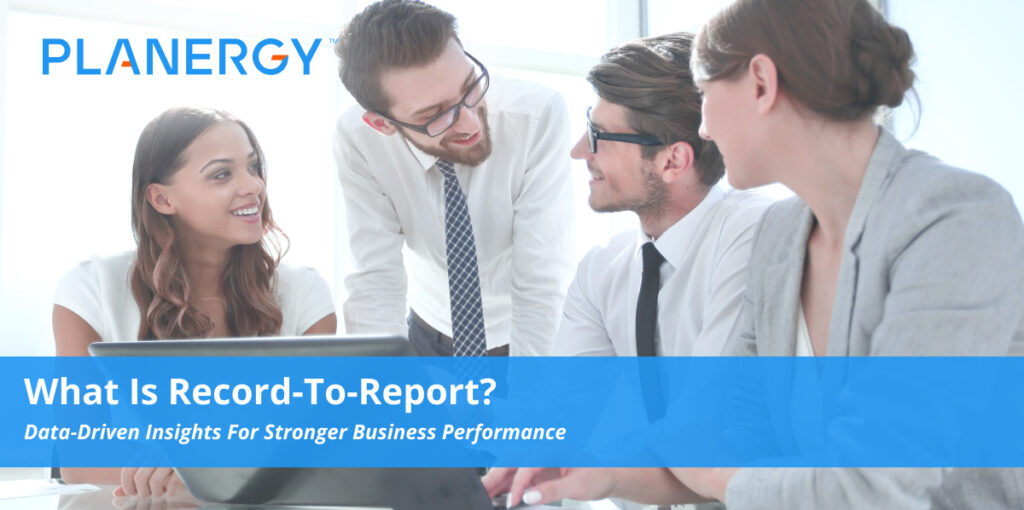Money may make the world go ’round, but it’s data that drives competitive strength and strategic insights for modern businesses of all sizes. One of the most important tools for transforming data into useful insights is the record to report process (R2R process).
A thorough understanding of how the record-to-report process works, and ways in which it can be optimized, will help any business achieve better strategic decision-making to improve its competitive footing and compliance, as well as meet its goals more quickly and effectively.
What is Record-to-Report (R2R)?
In finance and accounting, record-to-report is a management process used to collect, process, and present complete and accurate information on an organization’s strategic, financial, and operational performance.
By reviewing this information, stakeholders can garner useful insights into how well the organization is meeting expectations, as well as areas in need of improvement.
Since the record-to-report process affects your balance sheet, your strategic decision making, your overall financial planning, and your company’s ability to meet regulatory requirements, it makes good business sense to streamline and improve it wherever possible.
What is the Record-to-Report Process?
While companies rarely develop completely identical workflows for common processes, following best practices for the record-to-report process generally means transforming data into useful insights via four distinct stages.
These stages may vary in complexity, as larger organizations dealing with the intricacies of intercompany accounting will likely need to expend greater effort and resources to ensure they have up-to-date, accurate financial data from across their entire organization.
At the other end of the spectrum, smaller businesses may find themselves saddled with extra work due to manual workflows or legacy systems that make data management more challenging.
Twists in the road aside, most organizations will follow the same path during the R2R process:
1. Data Collection and Optimization
At this stage, the finance team collects what’s known as master data. This includes all the financial data required to generate finance statements and management reports (including journal entries). Sources include all of the spend data from your procure-to-pay (P2P) cycle across business units, including general accounting activities.
The goal here is swift, complete, and accurate collection of the data. Clean data in, accurate and useful reports and insights out.
2. Closing
The closing process (also called financial close, the close process, or the closing cycle) is an accounting process performed at the end of a specific accounting period (e.g., month-end).
The goal is to ensure the general ledger is complete, accurate, and closed out so the company’s financial data is ready for the next stage in the record-to-report process.
Time is of the essence during close, so once again it pays to prioritize speed as well as accuracy and completeness. Finding ways to minimize both human error and delays are at the top of the list during closing.
3. Account Reconciliation and Validation
Once closing is complete, the accounting team will validate all the information collected to ensure it is complete and accurate.
This is the final step before the data will be converted into financial statements and reports filled with operational feedback for both internal and external stakeholders.
4. Data Analysis and Reporting
The verified data is organized and analyzed, then used to create financial reports detailing the organization’s profitability, compliance information, and overall performance.
These reports are typically sent to the chief financial officer (CFO) and the rest of the C-suite, senior management, and the leaders of business units and divisions within the organization, as well as external stakeholders such as regulatory bodies and the company’s investors.
Automate to Accelerate and Optimize Your R2R Process
Companies rarely develop identical business processes for even common workflows.
But since the record-to-report process affects your balance sheet, your strategic decision making, your overall financial planning, and your company’s ability to meet regulatory requirements, it makes good business sense to streamline and improve it wherever possible.
To that end, a software solution like PLANERGY provides powerful optimization tools that reduce frustration while maximizing efficiency and accuracy.
- A centralized, comprehensive, and cloud-based data management system makes it easier to capture, organize, and analyze all your financial, compliance, and performance data.
- Supports elimination of legacy systems and manual, paper-based workflows.
- Creates a fully integrated software environment that improves collaboration, process speeds, and data management, with support for accounting software, enterprise resource planning systems (ERP systems), etc.
- Supports standardization and the use of key performance indicators (KPIs) to measure performance and compliance across all data sources.
- Process automation eliminates the need for data entry, along with the risk of human error and the time and expense that come with corrections.
- Automation and artificial intelligence simplify the entire procure-to-pay process.
- Guided buying and other internal controls improve compliance, ensure spend transparency, and reduce or eliminate rogue spend and invoice fraud.
- Automated approvals and AI-driven contingencies and reminders improve cycle times and avoid costly delays.
- Automatic three-way matching and other data management tools simplify reporting and strengthen compliance.
- Mobile-friendly, role-appropriate access to all data via intuitive dashboards makes it easier for stakeholders to access and analyze data in real time for improved strategic decision support.
The end result? Faster, more accurate and transparent financial reporting with reduced risk exposure, better compliance, and a much more collaborative and versatile approach to harvesting insights from your data stream.
Put Your Financial Data to Work for a Strong, Strategic Business
Modern businesses rely on data-based insights to drive innovation, growth, and value creation.
Make sure your data is clean, accurate, and complete by optimizing your record-to-report process with help from advanced digital tools.
You’ll cut costs, enjoy better regulatory compliance, build value through process optimization, and improve your company’s competitive and strategic strength through better decision-making and financial planning.




